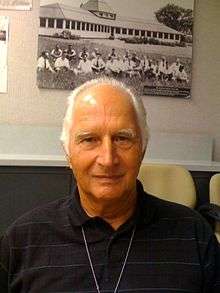Herwig Kogelnik
| Herwig Kogelnik | |
|---|---|
 | |
| Born |
June 2, 1932 Graz, Austria |
| Residence | United States |
| Nationality | American |
| Fields | Electrical engineering |
| Institutions | Bell Labs, Alcatel-Lucent |
| Alma mater | Oxford University |
| Notable awards |
IEEE Medal of Honor Marconi Prize National Medal of Technology Laureate Frederic Ives Medal IEEE David Sarnoff Award Joseph Johann Ritter von Prechtl Medal IEEE Lasers and Electro Optics Society Quantum Electronics Award |
Herwig Kogelnik (born June 2, 1932) has made fundamental contributions to developments in laser technology, optoelectronics, photonics and lightwave communications systems. His work over a 40-year career at Bell Labs earned him the Marconi Prize, the IEEE Medal of Honor, the National Medal of Technology and many other awards. In a series of papers in the early 1960s, he developed the theory of stable optical resonators, which has been fundamental to laser developments ever since. He then turned to the applications of holograms to optical systems, developing with some of his colleagues the basic theory of thick holograms that led to the development of a whole range of optical components, including filters and couplers to integrated optical devices. His innovation was the beginning of the "distributed feedback laser." He also contributed the development of wavelength-division multiplexing.[1]
Biography
He was born in Graz, Austria on June 2, 1932. He received an engineering degree from the Technische Hochschule in Vienna, Austria in 1955, and also a Doctor of Technology Degree in 1958. In 1960 he received a DPhil from St Peter's College, Oxford University. In 1961 he joined Bell Laboratories in Holmdel, New Jersey where he became Director of both the Electronics Research Laboratory and the Photonics Research Laboratory. He was the president of the Optical Society of America in 1989.[2] He holds 35 patents. In 2012 he continued active engineering work.
References
- ↑ "Herwig Kogelnik awarded the Marconi Prize in 2001". Marconi Society.
- ↑ "Past Presidents of the Optical Society of America". Optic Society of America.